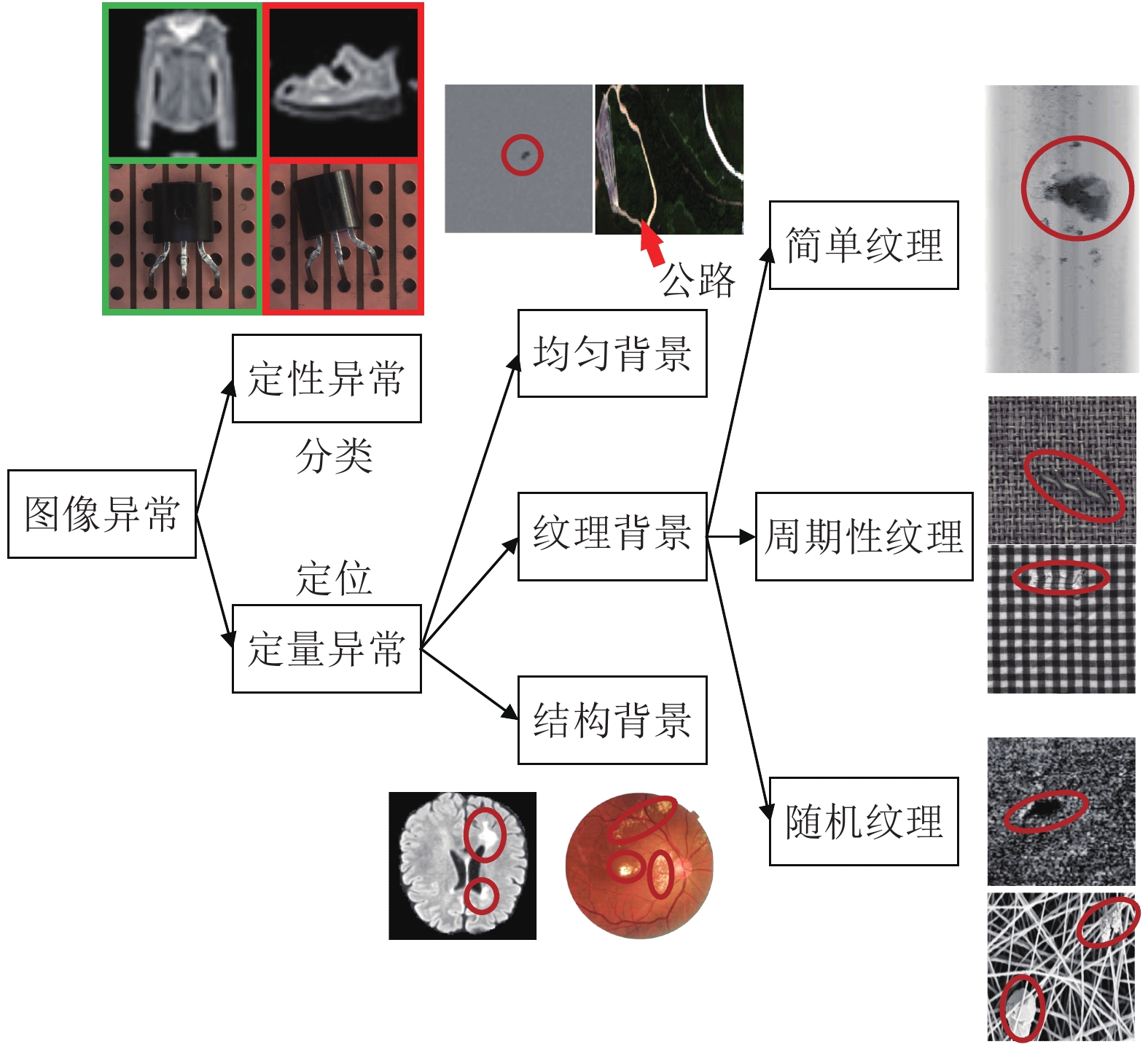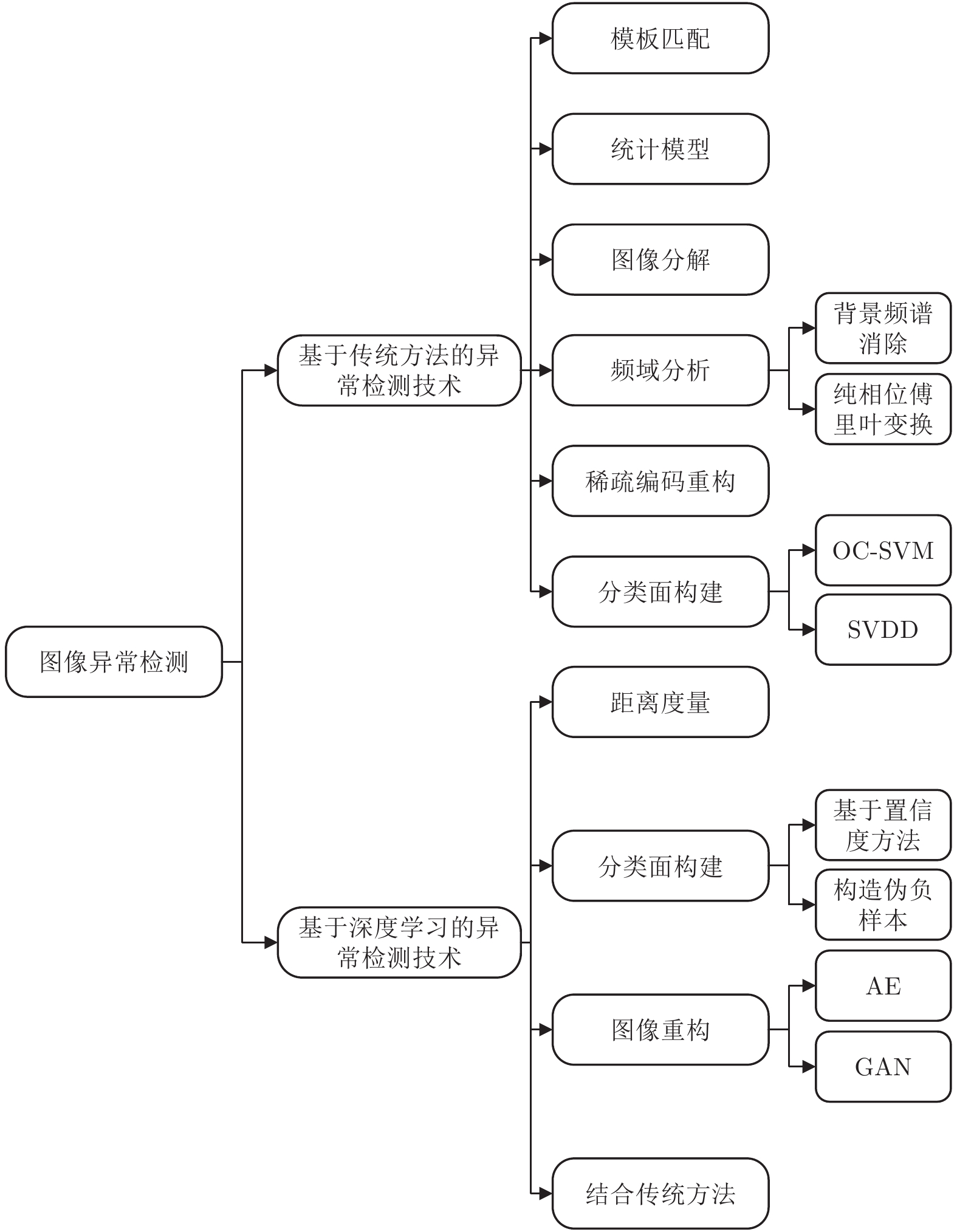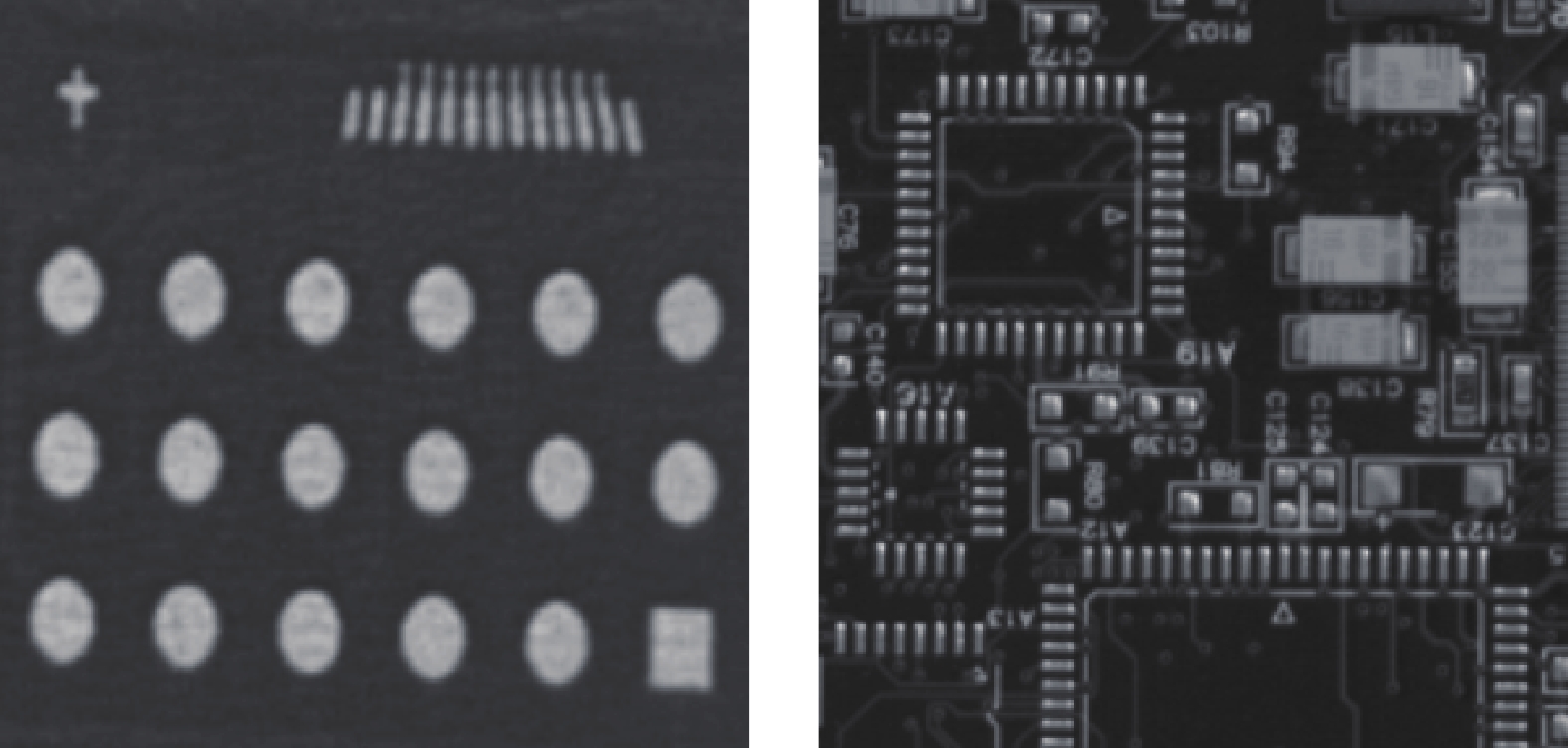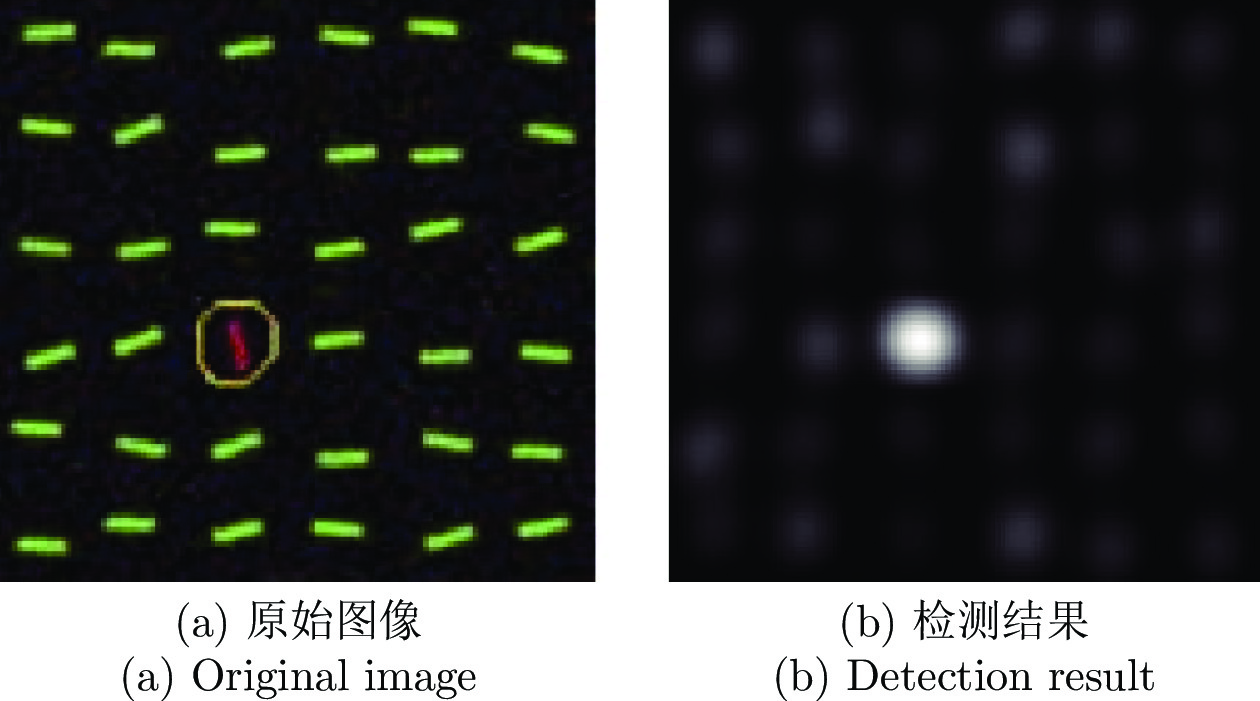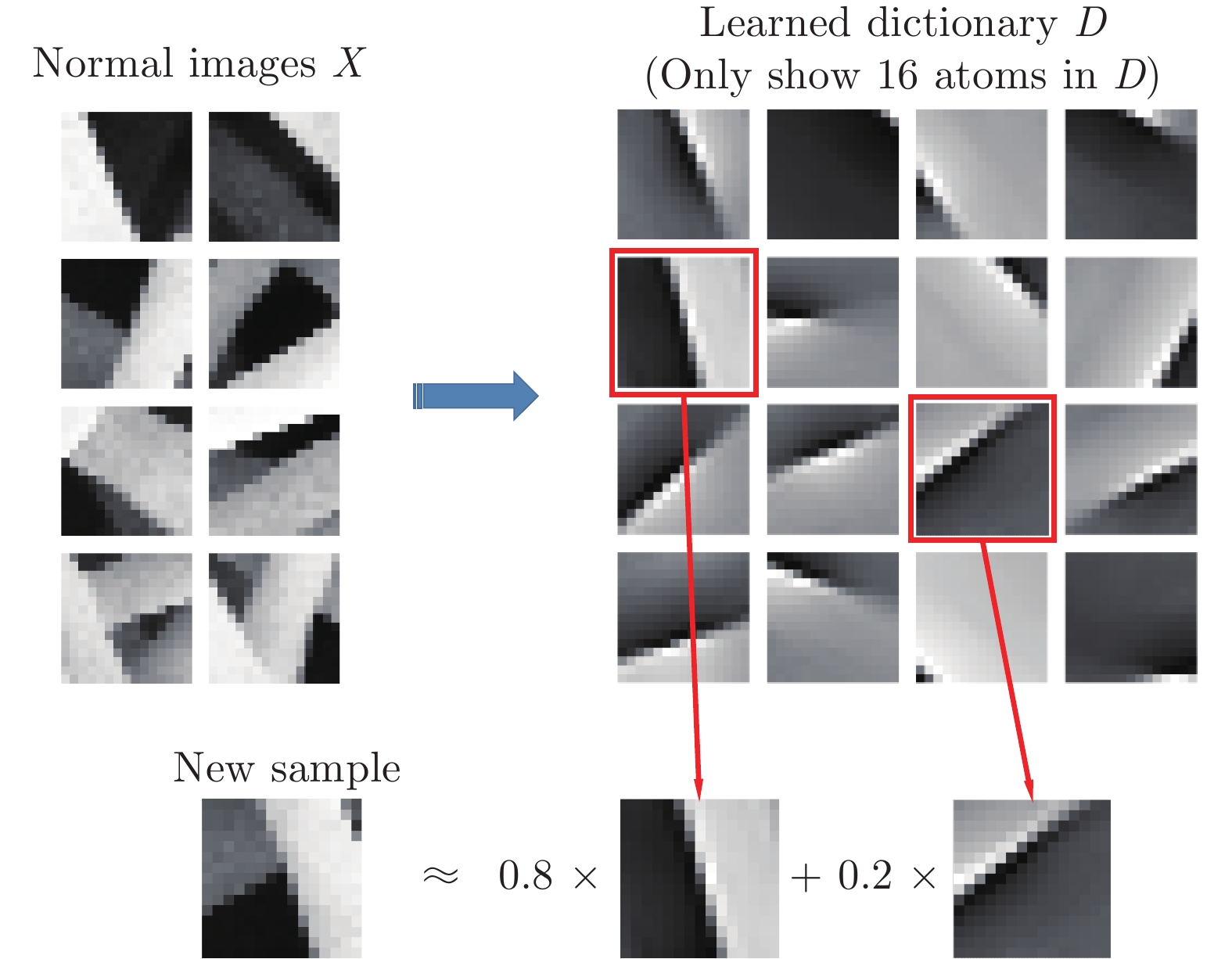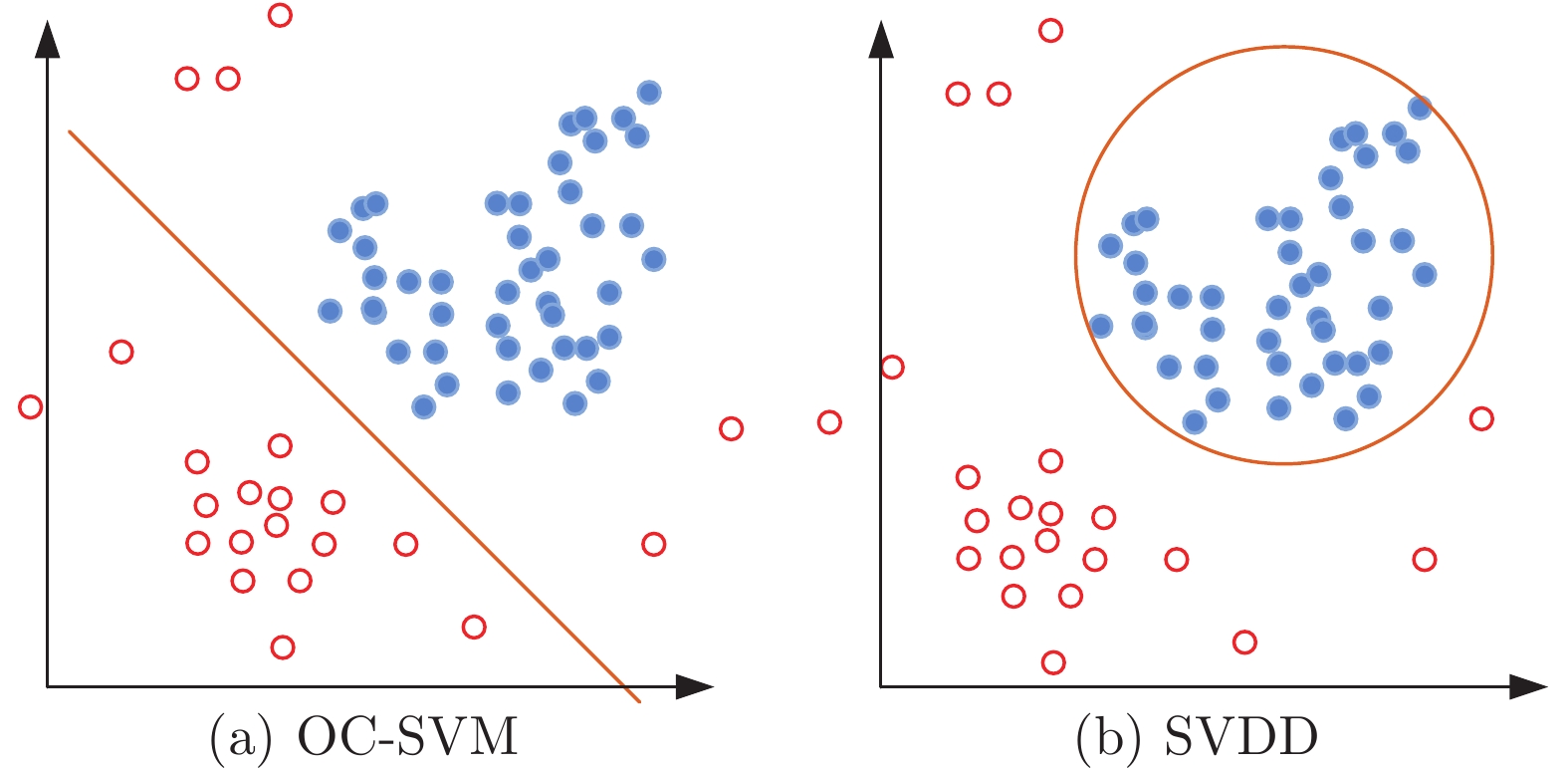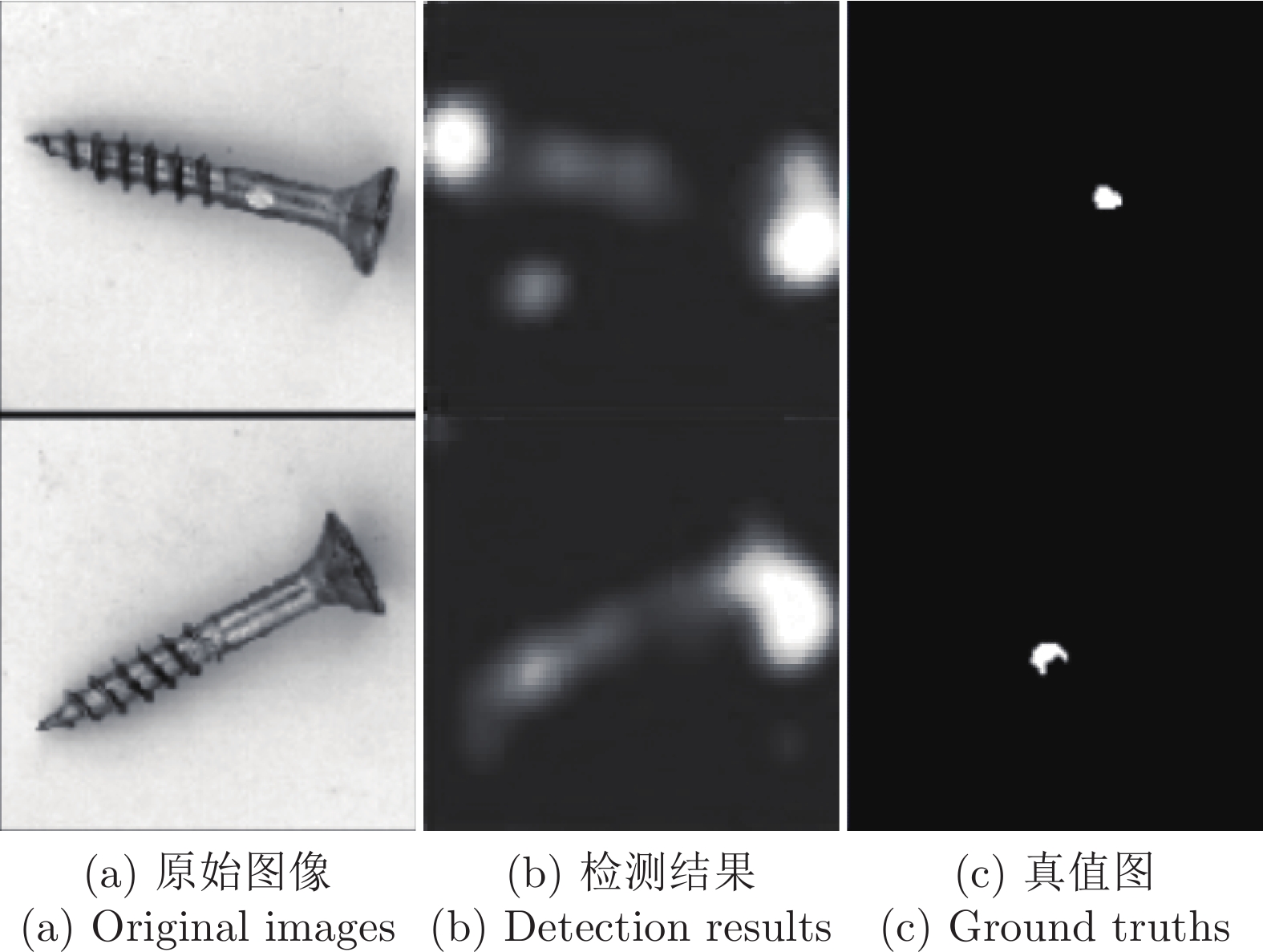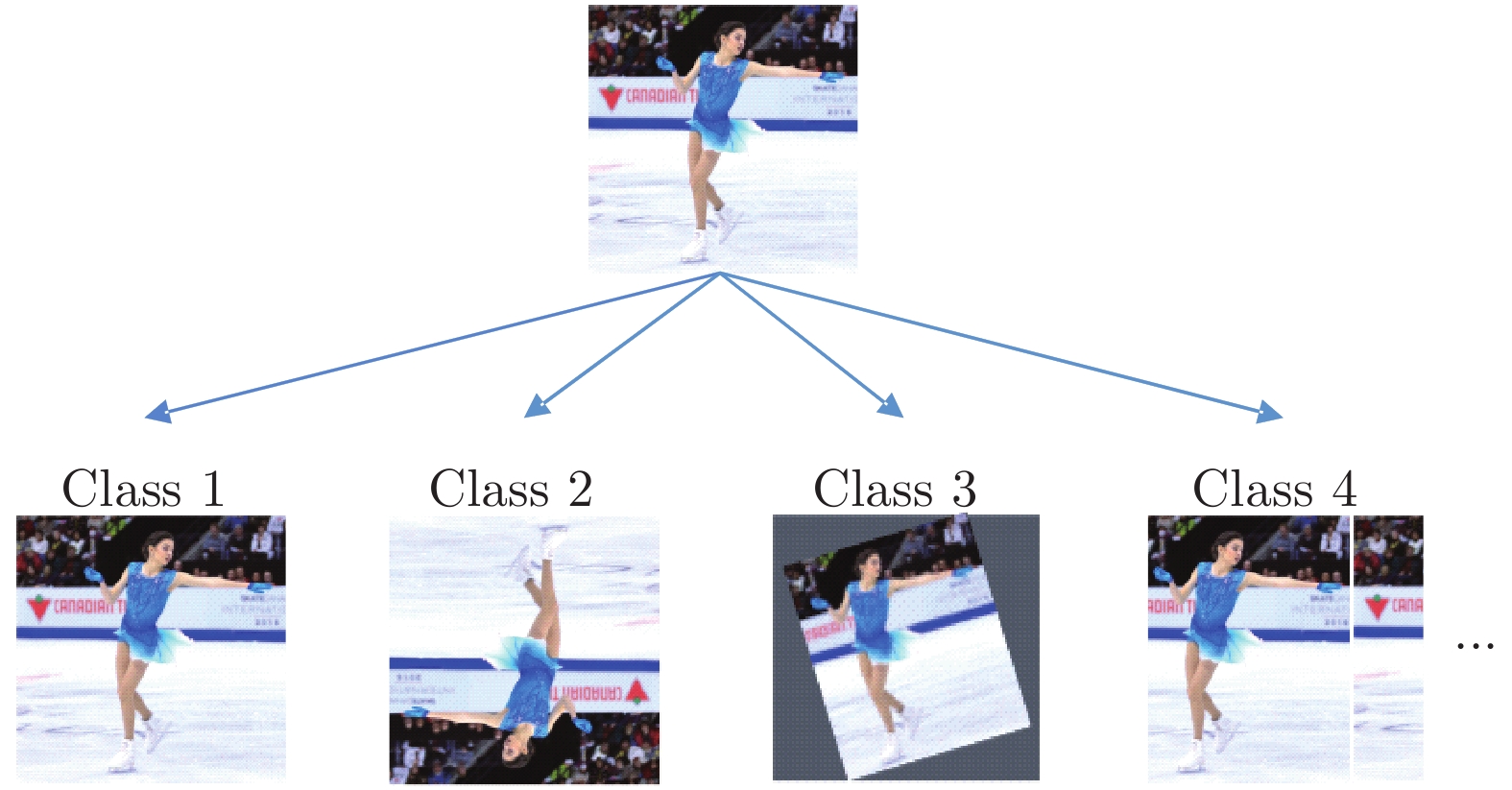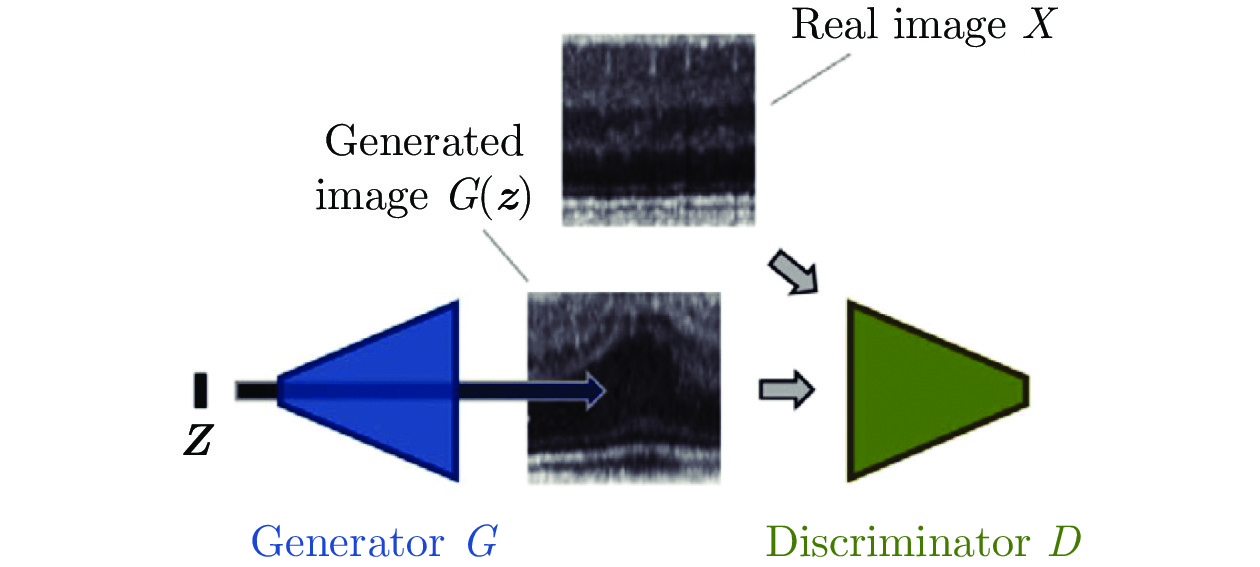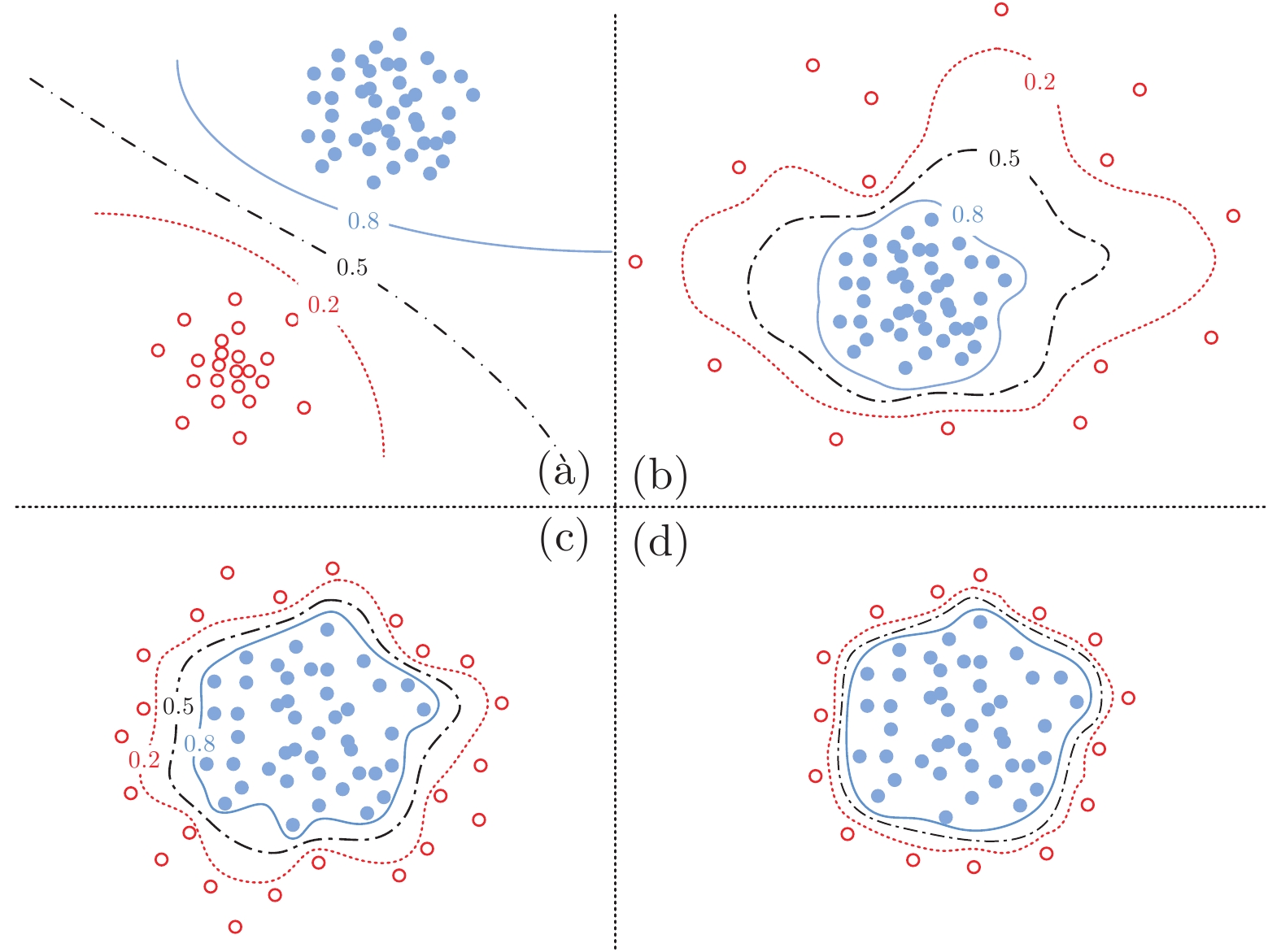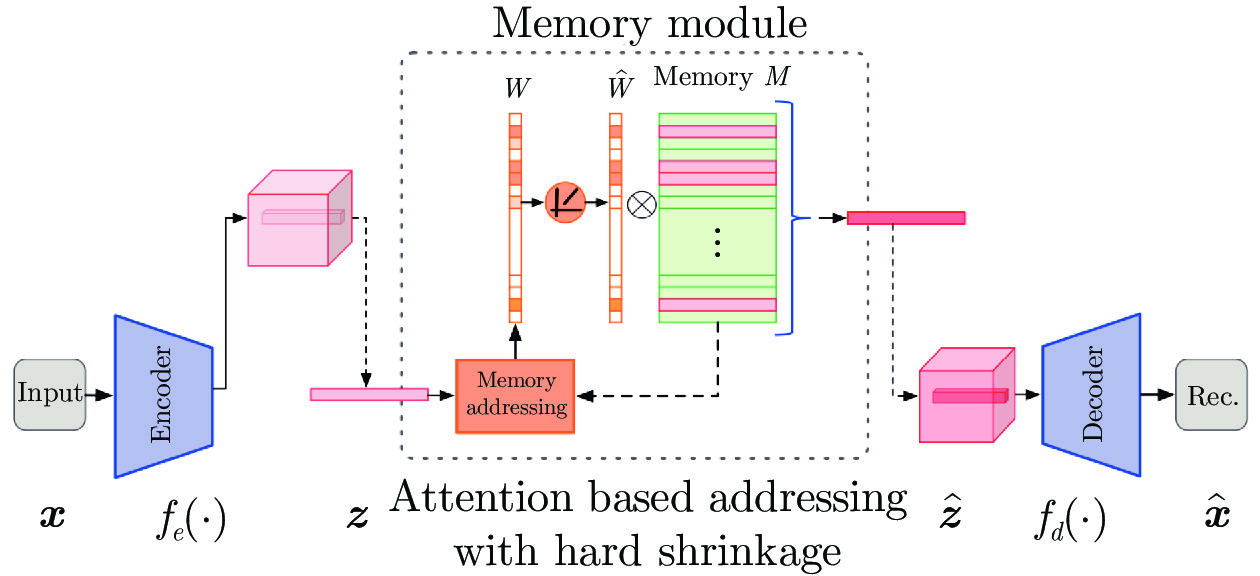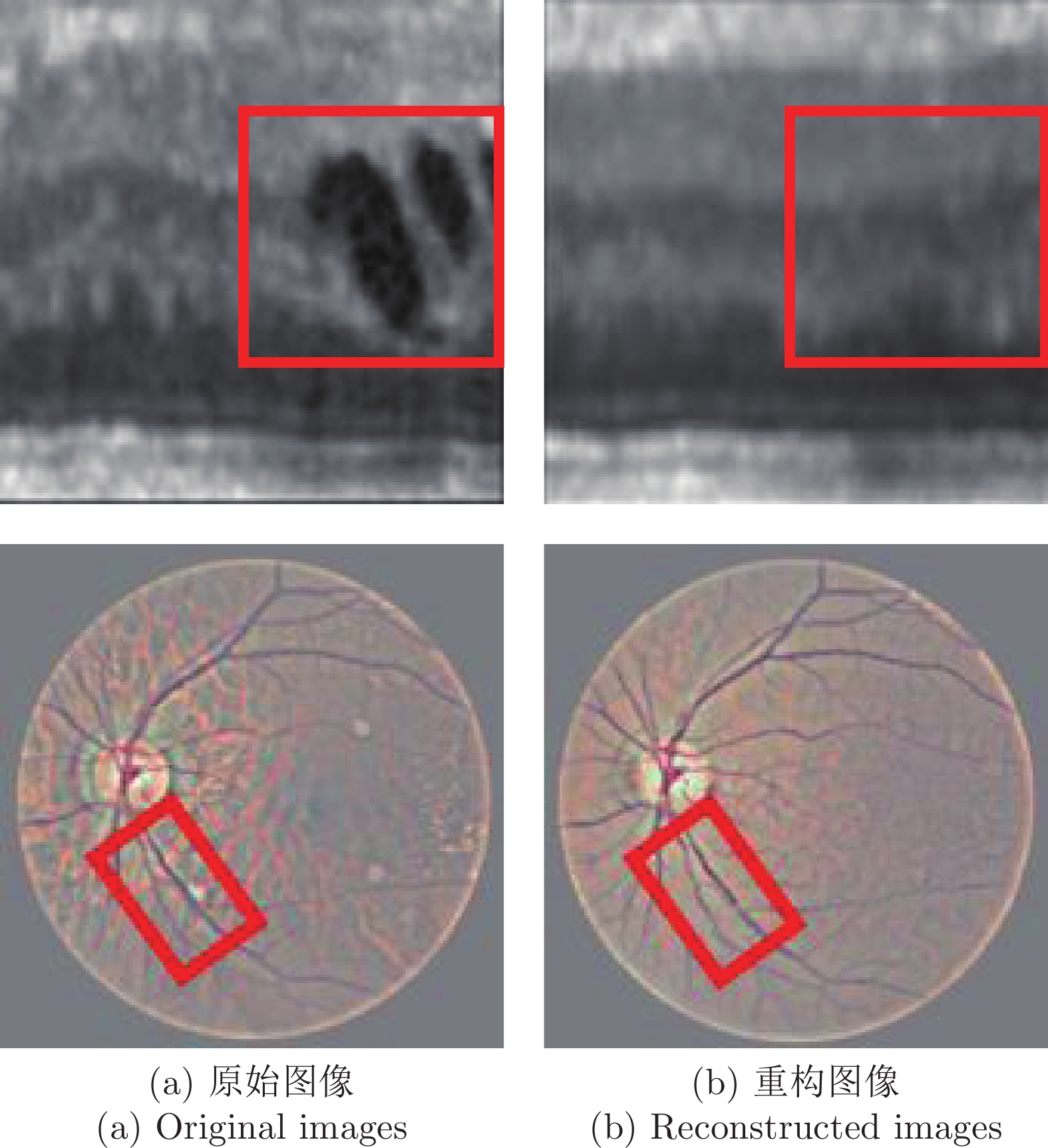-
摘要: 图像异常检测是计算机视觉领域的一个热门研究课题, 其目标是在不使用真实异常样本的情况下, 利用现有的正常样本构建模型以检测可能出现的各种异常图像, 在工业外观缺陷检测、医学图像分析、高光谱图像处理等领域有较高的研究意义和应用价值. 本文首先介绍了异常的定义以及常见的异常类型. 然后, 本文根据在模型构建过程中有无神经网络的参与, 将图像异常检测方法分为基于传统方法和基于深度学习两大类型, 并分别对相应的检测方法的设计思路、优点和局限性进行了综述与分析. 其次, 梳理了图像异常检测任务中面临的主要挑战. 最后, 对该领域未来可能的研究方向进行了展望.Abstract: Image anomaly detection is a hot research topic in the field of computer vision, which aims at training a model by normal images to detect potential anomalous images without requiring any real anomalous images for training. Therefore, it has high research and application value in the fields of industrial surface defect detection, medical image analysis, and hyperspectral image processing. This paper firstly introduces the definition of anomaly and its common type. Secondly, image anomaly detection methods are divided into traditional and deep learning-based methods according to whether the neural network is involved. Meanwhile, the design ideas, advantages and limitations of these methods are summarized and analyzed respectively. Thirdly, the major challenges faced in image anomaly detection are introduced. Finally, the future directions of image anomaly detection are discussed.
-
Key words:
- Image anomaly detection /
- computer vision /
- deep learning /
- neural network /
- background reconstruction
-
表 1 图像异常检测的应用领域
Table 1 Applications of image anomaly detection
表 2 基于传统方法的图像异常检测技术的分类和特点
Table 2 The classification and characteristic of traditional image anomaly detection methods
方法类别 设计思路 优点 缺点 参考文献 模板匹配 建立待测图像和模板图像之间的对应关系, 通过比较得到异常区域 方法简单有效, 对于采集环境高度可控的场景有很高的检测精度 不适用于多变的场景或目标 [29−48] 统计模型 通过统计学方法构建背景模型 具有详实的理论基础和推导过程, 检测速度快 需要大量的训练样本, 且仅适用于一些简单背景下的异常检测 [49−54] 图像分解 将原始图像分解成代表背景的低秩矩阵和代表异常区域的稀疏矩阵 具有详实的理论基础且无需训练过程 速度较慢, 而且不适合在结构复杂的图像中进行异常检测 [56−61] 频域分析 通过编辑图像的频谱信息来消除图像中重复的背景纹理部分以凸显异常区域 无需训练过程, 检测速度很快 还需更详实的理论论证, 且仅适用于一些有重复性纹理的图像, 通用性较差 [64−70] 稀疏编码重构 借助稀疏编码和字典学习等方式学习正常样本的表示方法, 从重构误差和稀疏度等角度检测异常 适用于各种类型的图像, 通用性很好 检测时间长, 而且需要额外的空间保存过完备的字典. [71−78] 分类面构建 建立分类面将现有的正常样本和潜在的异常样本进行区分 通用性较好, 且速度较快 各项参数的选择过程较为复杂 [81−87] 表 3 基于深度学习的图像异常检测技术的分类和特点
Table 3 The classification and characteristic of deep learning based image anomaly detection
方法类别 设计思路 优点 缺点 参考文献 距离度量 将正常图像映射到指定区域内, 并减小正常特征之间距离, 根据待测图像的特征到聚类中心的距离进行异常检测 模型结构简单, 适用范围广 模型可能出现退化, 需要设计额外的辅助任务, 且无法准确定位异常区域 [88−98] 分类面构建 通过几何变换增广现有数据, 直接训练分类模型并利用置信度来检测异常 模型训练较为简单, 语义信息提取能力更强, 异常检测精度很高 几何变换的操作在纹理图像等场景下并不适用 [101−102] 寻找与正常样本近似的图像作为负样本来训练二分类网络, 构建正常图像与潜在异常图像间的分类面 应用场景广泛, 异常检测精度高 需要精心设计损失函数和生成的负样本, 模型设计复杂 [104−117] 图像重构 利用自编码器等模型学习正常图像的表达方式, 并根据待测图像的重构误差来进行异常检测 训练阶段无需引入额外的样本, 且应用场景广泛, 速度较快 一般的方法重构结果较为模糊, 且缺乏更为高效可靠的方法避免重构出异常区域 [118−134] 利用GAN来获得更为清晰的图像重构效果 应用场景广泛, 异常区域定位精度高 模型训练复杂, 而且缺乏理论上的保证 [135−147] 结合传统方法 利用预训练的网络或者自编码器模型对图像进行特征提取, 在决策阶段利用传统方法进行异常检测 相比传统方法精度更高通用性更好, 且速度较快 在检测精度上略有不足 [150−160] 表 4 图像异常检测常用数据集
Table 4 Common datasets for image anomaly detection
表 5 各图像异常定位方法在MVTec AD上的性能
Table 5 Performance of image anomaly localization methods on MVTec AD
方法 大致思路 定位性能 AUROC PRO-score AE[146] 利用自编码器进行图像重构 0.817 0.790 AnoGAN[15] 利用GAN中的生成器进行图像重构 0.743 0.443 Iterative Projection[134] 在图像重构基础上采用迭代优化寻找最优的正常图像 0.893 — AESc[172] 利用蒙特卡洛对重构网络进行Dropout并利用预测不确定性进行异常定位 0.86 — P-Net[16] 在图像重构过程中添加对纹理结构的约束 0.89 — Uninformed Students[97] 联合考虑待测图特征到目标特征之间的距离和方差进行异常定位 — 0.857 CAVGA[144] 在图像重构的基础上采用注意力图定位异常区域 0.93 — FCDD[96] 利用全卷积网络提取特征并以偏置项作为特征映射中心 0.96 — Patch SVDD[173] 计算待检图像片和最近似的正常图像片之间的距离进行异常定位 0.957 — PaDiM[171] 用预训练的网络进行特征提取, 利用多维高斯模型进行异常定位 0.975 0.921 SPADE[174] 寻找待测样本的K-近邻正常图像作为参考, 再通过距离度量进行异常检测 0.965 0.917 -
[1] Chandola V, Banerjee A, Kumar V. Anomaly detection: A survey. ACM Computing Surveys, 2009, 41(3): Article No. 15 [2] Ren S Q, He K M, Girshick R, Sun J. Faster R-CNN: Towards real-time object detection with region proposal networks. IEEE Transactions on Pattern Analysis and Machine Intelligence, 2017, 39(6): 1137-1149 doi: 10.1109/TPAMI.2016.2577031 [3] Tian Z, Shen C H, Chen H, He T. FCOS: Fully convolutional one-stage object detection. In: Proceedings of the 2019 IEEE/CVF International Conference on Computer Vision (ICCV). Seoul, Korea: IEEE, 2019. 9626−9635 [4] Choi J, Kim C. Unsupervised detection of surface defects: A two-step approach. In: Proceedings of the 19th IEEE International Conference on Image Processing (ICIP). Orlando, USA: IEEE, 2012. 1037−1040 [5] Griffin L D, Caldwell M, Andrews J T A, Bohler H. “Unexpected item in the bagging area”: Anomaly detection in X-ray security images. IEEE Transactions on Information Forensics and Security, 2019, 14(6): 1539-1553 doi: 10.1109/TIFS.2018.2881700 [6] Ahn E, Kumar A, Feng D G, Fulham M, Kim J. Unsupervised deep transfer feature learning for medical image classification. In: Proceedings of the 16th International Symposium on Biomedical Imaging (ISBI). Venice, Italy: IEEE, 2019. 1915−1918 [7] Agyemang M, Barker K, Alhajj R. A comprehensive survey of numeric and symbolic outlier mining techniques. Intelligent Data Analysis, 2006, 10(6): 521-538 doi: 10.3233/IDA-2006-10604 [8] Li C L, Gao G S, Liu Z F, Huang D, Xi J T. Defect detection for patterned fabric images based on GHOG and low-rank decomposition. IEEE Access, 2019, 7: 83962-83973 doi: 10.1109/ACCESS.2019.2925196 [9] Lv C K, Zhang Z T, Shen F, Zhang F, Su H. A fast surface defect detection method based on background reconstruction. International Journal of Precision Engineering and Manufacturing, 2020, 21(3): 363-375 doi: 10.1007/s12541-019-00262-2 [10] Wang J Z, Li Q Y, Gan J R, Yu H M, Yang X. Surface defect detection via entity sparsity pursuit with intrinsic priors. IEEE Transactions on Industrial Informatics, 2020, 16(1): 141-150 doi: 10.1109/TII.2019.2917522 [11] Yang H, Chen Y F, Song K Y, Yin Z P. Multiscale feature-clustering-based fully convolutional autoencoder for fast accurate visual inspection of texture surface defects. IEEE Transactions on Automation Science and Engineering, 2019, 16(3): 1450-1467 doi: 10.1109/TASE.2018.2886031 [12] Bai X L, Fang Y M, Lin W S, Wang L P, Ju B F. Saliency-based defect detection in industrial images by using phase spectrum. IEEE Transactions on Industrial Informatics, 2014, 10(4): 2135-2145 doi: 10.1109/TII.2014.2359416 [13] Zhou W J, Fei M R, Zhou H Y, Li K. A sparse representation based fast detection method for surface defect detection of bottle caps. Neurocomputing, 2014, 123: 406-414 doi: 10.1016/j.neucom.2013.07.038 [14] Baur C, Wiestler B, Albarqouni S, Navab N. Bayesian skip-autoencoders for unsupervised hyperintense anomaly detection in high resolution brain mri. In: Proceedings of the 17th International Symposium on Biomedical Imaging (ISBI). Iowa City, USA: IEEE, 2020. 1905−1909 [15] Schlegl T, Seeböck P, Waldstein S M, Schmidt-Erfurth U, Langs G. Unsupervised anomaly detection with generative adversarial networks to guide marker discovery. In: Proceedings of the 25th International Conference on Information Processing in Medical Imaging (IPMI). Boone, USA: Springer, 2017. 146−157 [16] Zhou K, Xiao Y T, Yang J L, Cheng J, Liu W, Luo W X, et al. Encoding structure-texture relation with P-net for anomaly detection in retinal images. In: Proceedings of the 16th European Conference on Computer Vision (ECCV). Glasgow, UK: Springer, 2020. 360−377 [17] Wang N, Li B, Xu Q Z, Wang Y H. Automatic ship detection in optical remote sensing images based on anomaly detection and SPP-PCANet. Remote Sensing, 2019, 11(1): Article No. 47 [18] Jiang T, Li Y S, Xie W Y, Du Q. Discriminative reconstruction constrained generative adversarial network for hyperspectral anomaly detection. IEEE Transactions on Geoscience and Remote Sensing, 2020, 58(7): 4666-4679 doi: 10.1109/TGRS.2020.2965961 [19] Jiang K, Xie W Y, Li Y S, Lei J, He G, Du Q. Semisupervised spectral learning with generative adversarial network for hyperspectral anomaly detection. IEEE Transactions on Geoscience and Remote Sensing, 2020, 58(7): 5224-5236 doi: 10.1109/TGRS.2020.2975295 [20] Ehret T, Davy A, Morel J M, Delbracio M. Image anomalies: A review and synthesis of detection methods. Journal of Mathematical Imaging and Vision, 2019, 61(5): 710-743 doi: 10.1007/s10851-019-00885-0 [21] Pang G S, Shen C H, Cao L B, Van Den Hengel A. Deep learning for anomaly detection: A review. ACM Computing Surveys, 2022, 54(2): Article No. 38 [22] Chalapathy R, Chawla S. Deep learning for anomaly detection: A survey [Online], available: https://arxiv.org/abs/1901.03407, January 23, 2019 [23] 陶显, 侯伟, 徐德. 基于深度学习的表面缺陷检测方法综述. 自动化学报, 2021, 47(5): 1017-1034Tao Xian, Hou Wei, Xu De. A survey of surface defect detection methods based on deep learning. Acta Automatica Sinica, 2021, 47(5): 1017-1034 [24] Pimentel M A F, Clifton D A, Clifton L, Tarassenko L. A review of novelty detection. Signal Processing, 2014, 99: 215-249 doi: 10.1016/j.sigpro.2013.12.026 [25] Hawkins D M. Identification of Outliers. London: Chapman and Hall, 1980. 1−12 [26] Cook A, M\imaths\imathrl\imath G, Fan Z. Anomaly detection for IoT time-series data: A survey. IEEE Internet of Things Journal, 2020, 7(7): 6481-6494 doi: 10.1109/JIOT.2019.2958185 [27] Goldman A, Cohen I. Anomaly detection based on an iterative local statistics approach. Signal Processing, 2004, 84(7): 1225-1229 doi: 10.1016/j.sigpro.2004.04.004 [28] Xiao H, Rasul K, Vollgraf R. Fashion-MNIST: A novel image dataset for benchmarking machine learning algorithms [Online], available: https://arxiv.org/abs/1708.07747, August 25, 2017 [29] 贾迪, 朱宁丹, 杨宁华, 吴思, 李玉秀, 赵明远. 图像匹配方法研究综述. 中国图象图形学报, 2019, 24(5): 677-699Jia Di, Zhu Ning-Dan, Yang Ning-Hua, Wu Si, Li Yu-Xiu, Zhao Ming-Yuan. Image matching methods. Journal of Image and Graphics, 2019, 24(5): 677-699 [30] Loog M, Lauze F. The improbability of Harris interest points. IEEE Transactions on Pattern Analysis and Machine Intelligence, 2010, 32(6): 1141-1147 doi: 10.1109/TPAMI.2010.53 [31] Lowe D G. Distinctive image features from scale-invariant keypoints. International Journal of Computer Vision, 2004, 60(2): 91-110 doi: 10.1023/B:VISI.0000029664.99615.94 [32] Morel J M, Yu G S. ASIFT: A new framework for fully affine invariant image comparison. SIAM Journal on Imaging Sciences, 2009, 2(2): 438-469 doi: 10.1137/080732730 [33] Rosten E, Porter R, Drummond T. Faster and better: A machine learning approach to corner detection. IEEE Transactions on Pattern Analysis and Machine Intelligence, 2010, 32(1): 105-119 doi: 10.1109/TPAMI.2008.275 [34] Verdie Y, Yi K M, Fua P, Lepetit V. TILDE: A temporally invariant learned detector. In: Proceedings of the 2015 IEEE Conference on Computer Vision and Pattern Recognition (CVPR). Boston, USA: IEEE, 2015. 5279−5288 [35] Wang Z H, Wu F C, Hu Z Y. MSLD: A robust descriptor for line matching. Pattern Recognition, 2009, 42(5): 941-953 doi: 10.1016/j.patcog.2008.08.035 [36] Zhang L L, Koch R. An efficient and robust line segment matching approach based on LBD descriptor and pairwise geometric consistency. Journal of Visual Communication and Image Representation, 2013, 24(7): 794-805 doi: 10.1016/j.jvcir.2013.05.006 [37] Xia M H, Liu B. Image registration by "Super-curves". IEEE Transactions on Image Processing, 2004, 13(5): 720-732 doi: 10.1109/TIP.2003.822611 [38] Wolfson H J. On curve matching. IEEE Transactions on Pattern Analysis and Machine Intelligence, 1990, 12(5): 483-489 doi: 10.1109/34.55108 [39] Pratt W K. Correlation techniques of image registration. IEEE Transactions on Aerospace and Electronic Systems, 1974, AES-10(3): 353-358 doi: 10.1109/TAES.1974.307828 [40] Leese J A, Novak C S, Clark B B. An automated technique for obtaining cloud motion from geosynchronous satellite data using cross correlation. Journal of Applied Meteorology and Climatology, 1971, 10(1): 118-132 doi: 10.1175/1520-0450(1971)010<0118:AATFOC>2.0.CO;2 [41] Korman S, Reichman D, Tsur G, Avidan S. FasT-match: Fast affine template matching. In: Proceedings of the 2013 IEEE Conference on Computer Vision and Pattern Recognition (CVPR). Portland, USA: IEEE, 2013. 2331−2338 [42] Jia D, Cao J, Song W D, Tang X L, Zhu H. Colour FAST (CFAST) match: Fast affine template matching for colour images. Electronics Letters, 2016, 52(14): 1220-1221 doi: 10.1049/el.2016.1331 [43] Han X F, Leung T, Jia Y Q, Sukthankar R, Berg A C. MatchNet: Unifying feature and metric learning for patch-based matching. In: Proceedings of the 2015 IEEE Conference on Computer Vision and Pattern Recognition (CVPR). Boston, USA: IEEE, 2015. 3279−3286 [44] Balntas V, Johns E, Tang L L, Mikolajczyk K. PN-Net: Conjoined triple deep network for learning local image descriptors [Online], available: https://arxiv.org/abs/1601.05030v1, Jannuary 16, 2016 [45] Chen W J, Ho J H, Mustapha K B, Chai T Y. A vision based system for anomaly detection and classification in additive manufacturing. In: Proceedings of the 2019 IEEE Conference on Sustainable Utilization and Development in Engineering and Technologies (CSUDET). Penang, Malaysia: IEEE, 2019. 87−92 [46] Vaikundam S, Hung T Y, Chia L T. Anomaly region detection and localization in metal surface inspection. In: Proceedings of the 2016 IEEE International Conference on Image Processing (ICIP). Phoenix, USA: IEEE, 2016. 759−763 [47] Herwig J, Le\ssmann S, Bürger F, Pauli J. Adaptive anomaly detection within near-regular milling textures. In: Proceedings of the 8th International Symposium on Image and Signal Processing and Analysis (ISPA). Trieste, Italy: IEEE, 2013. 113−118 [48] Tsai D M, Huang C K. Defect detection in electronic surfaces using template-based Fourier image reconstruction. IEEE Transactions on Components, Packaging and Manufacturing Technology, 2019, 9(1): 163-172 doi: 10.1109/TCPMT.2018.2873744 [49] Reed I S, Yu X. Adaptive multiple-band CFAR detection of an optical pattern with unknown spectral distribution. IEEE Transactions on Acoustics, Speech, and Signal Processing, 1990, 38(10): 1760-1770 doi: 10.1109/29.60107 [50] Du B, Zhang L P. Random-selection-based anomaly detector for hyperspectral imagery. IEEE Transactions on Geoscience and Remote Sensing, 2011, 49(5): 1578-1589 doi: 10.1109/TGRS.2010.2081677 [51] Veracini T, Matteoli S, Diani M, Corsini G. Fully unsupervised learning of Gaussian mixtures for anomaly detection in hyperspectral imagery. In: Proceedings of the 9th International Conference on Intelligent Systems Design and Applications. Pisa, Italy: IEEE, 2009. 596−601 [52] Zhang H, Jin X T, Wu Q M J, Wang Y N, He Z D, Yang Y M. Automatic visual detection system of railway surface defects with curvature filter and improved Gaussian mixture model. IEEE Transactions on Instrumentation and Measurement, 2018, 67(7): 1593-1608 doi: 10.1109/TIM.2018.2803830 [53] Schaum A. Joint subspace detection of hyperspectral targets. In: Proceedings of the 2004 IEEE Aerospace Conference Proceedings (IEEE Cat. No.04TH8720). Big Sky, USA: IEEE, 2004. Article No. 1824 [54] Molero J M, Garzón E M, García I, Plaza A. Analysis and optimizations of global and local versions of the RX algorithm for anomaly detection in hyperspectral data. IEEE Journal of Selected Topics in Applied Earth Observations and Remote Sensing, 2013, 6(2): 801-814 doi: 10.1109/JSTARS.2013.2238609 [55] Mishne G, Cohen I. Multiscale anomaly detection using diffusion maps. IEEE Journal of Selected Topics in Signal Processing, 2013, 7(1): 111-123 doi: 10.1109/JSTSP.2012.2232279 [56] 杨恩君, 廖义辉, 刘安东, 俞立. 基于低秩分解的织物疵点检测. 纺织学报, 2020, 41(5): 72-78Yang En-Jun, Liao Yi-Hui, Liu An-Dong, Yu Li. Detection for fabric defects based on low-rank decomposition. Journal of Textile Research, 41(5): 72-78 [57] Li C L, Liu C D, Gao G S, Liu Z F, Wang Y P. Robust low-rank decomposition of multi-channel feature matrices for fabric defect detection. Multimedia Tools and Applications, 2019, 78(6): 7321-7339 doi: 10.1007/s11042-018-6483-6 [58] Zhou T Y, Tao D C. GoDec: Randomized low-rank & sparse matrix decomposition in noisy case. In: Proceedings of the 28th International Conference on Machine Learning (ICML). Bellevue, USA: PMLR, 2011. 33−40 [59] Zhang Y X, Du B, Zhang L P, Wang S G. A low-rank and sparse matrix decomposition-based Mahalanobis distance method for hyperspectral anomaly detection. IEEE Transactions on Geoscience and Remote Sensing, 2016, 54(3): 1376-1389 doi: 10.1109/TGRS.2015.2479299 [60] Wang J Z, Li Q Y, Gan J R, Yu H M. Fabric defect detection based on improved low-rank and sparse matrix decomposition. In: Proceedings of the 2017 IEEE International Conference on Image Processing (ICIP). Beijing, China: IEEE, 2017. 2776−2780 [61] Yang Y X, Zhang J Q, Song S Z, Zhang C, Liu D L. Low-rank and sparse matrix decomposition with orthogonal subspace projection-based background suppression for hyperspectral anomaly detection. IEEE Geoscience and Remote Sensing Letters, 2020, 17(8): 1378-1382 doi: 10.1109/LGRS.2019.2948675 [62] Guo C L, Ma Q, Zhang L M. Spatio-temporal Saliency detection using phase spectrum of quaternion Fourier transform. In: Proceedings of the 2008 IEEE Conference on Computer Vision and Pattern Recognition (CVPR). Anchorage, USA: IEEE, 2008. 1−8 [63] Zhang H X, Guo Z D, Qi Z G, Wang J G. Research of glass defects detection based on DFT and optimal threshold method. In: Proceedings of the 2012 International Conference on Computer Science and Information Processing (CSIP). Xi'an, China: IEEE, 2012. 1044−1047 [64] Liu H X, Zhou W, Kuang Q W, Cao L, Gao B. Defect detection of IC wafer based on spectral subtraction. IEEE Transactions on Semiconductor Manufacturing, 2010, 23(1): 141-147 doi: 10.1109/TSM.2009.2039185 [65] Tsai D M, Huang T Y. Automated surface inspection for statistical textures. Image and Vision Computing, 2003, 21(4): 307-323 doi: 10.1016/S0262-8856(03)00007-6 [66] Tsai D M, Hsieh C Y. Automated surface inspection for directional textures. Image and Vision Computing, 1999, 18(1): 49-62 doi: 10.1016/S0262-8856(99)00009-8 [67] Hou X D, Zhang L Q. Saliency detection: A spectral residual approach. In: Proceedings of the 2007 IEEE Conference on Computer Vision and Pattern Recognition (CVPR). Minneapolis, USA: IEEE, 2007. 1−8 [68] Li J, Levine M D, An X J, Xu X, He H G. Visual saliency based on scale-space analysis in the frequency domain. IEEE Transactions on Pattern Analysis and Machine Intelligence, 2013, 35(4): 996-1010 doi: 10.1109/TPAMI.2012.147 [69] Aiger D, Talbot H. The phase only transform for unsupervised surface defect detection. In: Proceedings of the 2010 IEEE Computer Society Conference on Computer Vision and Pattern Recognition. San Francisco, USA: IEEE, 2010. 295−302 [70] Tsai D M, Kuo C C. Defect detection in inhomogeneously textured sputtered surfaces using 3D Fourier image reconstruction. Machine Vision and Applications, 2007, 18(6): 383-400 doi: 10.1007/s00138-007-0073-3 [71] Carrera D, Manganini F, Boracchi G, Lanzarone E. Defect detection in SEM images of nanofibrous materials. IEEE Transactions on Industrial Informatics, 2017, 13(2): 551-561 doi: 10.1109/TII.2016.2641472 [72] Liang L Q, Li D, Fu X, Zhang W J. Touch screen defect inspection based on sparse representation in low resolution images. Multimedia Tools and Applications, 2016, 75(5): 2655-2666 doi: 10.1007/s11042-015-2559-8 [73] Boracchi G, Carrera D, Wohlberg B. Novelty detection in images by sparse representations. In: Proceedings of the 2014 IEEE Symposium on Intelligent Embedded Systems (IES). Orlando, USA: IEEE, 2014. 47−54 [74] Boyd S, Parikh N, Chu E, Peleato B, Eckstein J. Distributed optimization and statistical learning via the alternating direction method of multipliers. Foundations and Trends® in Machine Learning, 2011, 3(1): 1-122 [75] Carrera D, Boracchi G, Foi A, Wohlberg B. Scale-invariant anomaly detection with multiscale group-sparse models. In: Proceedings of the 2016 IEEE International Conference on Image Processing (ICIP). Phoenix, USA: IEEE, 2016. 3892−3896 [76] Chen Y, Nasrabadi N M, Tran T D. Sparse representation for target detection in hyperspectral imagery. IEEE Journal of Selected Topics in Signal Processing, 2011, 5(3): 629-640 doi: 10.1109/JSTSP.2011.2113170 [77] Hyvärinen A, Oja E. Independent component analysis: Algorithms and applications. Neural Networks, 2000, 13(4-5): 411-430 doi: 10.1016/S0893-6080(00)00026-5 [78] Sezer O G, Ercil A, Ertuzun A. Using perceptual relation of regularity and anisotropy in the texture with independent component model for defect detection. Pattern Recognition, 2007, 40(1): 121-133 doi: 10.1016/j.patcog.2006.05.023 [79] Schölkopf B, Williamson R, Smola A, Shawe-Taylor J, Platt J. Support vector method for novelty detection. In: Proceedings of the 12th International Conference on Neural Information Processing Systems. Denver, USA: MIT Press, 1999. 582−588 [80] Amraee S, Vafaei A, Jamshidi K, Adibi P. Abnormal event detection in crowded scenes using one-class SVM. Signal, Image and Video Processing, 2018, 12(6): 1115-1123 doi: 10.1007/s11760-018-1267-z [81] Tax D M J, Duin R P W. Support vector data description. Machine Learning, 2004, 54(1): 45-66 doi: 10.1023/B:MACH.0000008084.60811.49 [82] Wang J, Cherian A. GODS: Generalized one-class discriminative subspaces for anomaly detection. In: Proceedings of the 2019 IEEE/CVF International Conference on Computer Vision (ICCV). Seoul, Korea: IEEE, 2019. 8200−8210 [83] Azami M E, Bouet R, Jung J, Hammers A, Lartizien C. Combining multi-parametric MR images for the detection of epileptogenic lesions. In: Proceedings of the 12th International Symposium on Biomedical Imaging (ISBI). Brooklyn, USA: IEEE, 2015. 122−125 [84] Zhang L Y, Sun Y H, Meng D, Li X J. Anomaly detection for hyperspectral imagery based on incremental support vector data description. In: Proceedings of the 2010 International Conference on Multimedia Technology. Ningbo, China: IEEE, 2010. 1−4 [85] Gurram P, Kwon H. Hyperspectral anomaly detection using an optimized support vector data description method. In: Proceedings of the 3rd Workshop on Hyperspectral Image and Signal Processing: Evolution in Remote Sensing (WHISPERS). Lisbon, Portugal: IEEE, 2011. 1−4 [86] Liu Y H, Liu Y C, Chen Y J. Fast support vector data descriptions for novelty detection. IEEE Transactions on Neural Networks, 2010, 21(8): 1296-1313 doi: 10.1109/TNN.2010.2053853 [87] Liu Y H, Lin S H, Hsueh Y L, Lee M J. Automatic target defect identification for TFT-LCD array process inspection using kernel FCM-based fuzzy SVDD ensemble. Expert Systems with Applications, 2009, 36(2): 1978-1998 doi: 10.1016/j.eswa.2007.12.015 [88] Ruff L, Vandermeulen R A, Göernitz N, Deecke L, Siddiqui S A, Binder A, et al. Deep one-class classification. In: Proceedings of the 35th International Conference on Machine Learning. Stockholm, Sweden: PMLR, 2018. 4390−4399 [89] Lecun Y, Bottou L, Bengio Y, Haffner P. Gradient-based learning applied to document recognition. Proceedings of the IEEE, 1998, 86(11): 2278-2324 doi: 10.1109/5.726791 [90] Krizhevsky A. Learning Multiple Layers of Features from Tiny Images. Technical Report TR-2009, University of Toronto, Canada, 2009. [91] Kitamura S, Nonaka Y. Explainable anomaly detection via feature-based localization. In: Proceedings of the 28th International Conference on Artificial Neural Networks (ICANN). Munich, Germany: Springer, 2019. 408−419 [92] Perera P, Patel V M. Learning deep features for one-class classification. IEEE Transactions on Image Processing, 2019, 28(11): 5450-5463 doi: 10.1109/TIP.2019.2917862 [93] Wu P, Liu J, Shen F. A deep one-class neural network for anomalous event detection in complex scenes. IEEE Transactions on Neural Networks and Learning Systems, 2020, 31(7): 2609-2622 [94] Bergman L, Hoshen Y. Classification-based anomaly detection for general data. In: Proceedings of the 8th International Conference on Learning Representations (ICLR). Addis Ababa, Ethiopia: OpenReview.net, 2020. [95] He X W, Zhou Y, Zhou Z C, Bai S, Bai X. Triplet-center loss for multi-view 3D object retrieval. In: Proceedings of the 2018 IEEE/CVF Conference on Computer Vision and Pattern Recognition (CVPR). Salt Lake City, USA: IEEE, 2018. 1945−1954 [96] Liznerski P, Ruff L, Vandermeulen R A, Franks B J, Kloft M, Müller K R. Explainable deep one-class classification. In: Proceedings of the 9th International Conference on Learning Representations. Vienna, Austria: OpenReview.net, 2021. [97] Bergmann P, Fauser M, Sattlegger D, Steger C. Uninformed students: Student-teacher anomaly detection with discriminative latent embeddings. In: Proceedings of the 2020 IEEE/CVF Conference on Computer Vision and Pattern Recognition (CVPR). Seattle, USA: IEEE, 2020. 4182−4191 [98] Ruff L, Vandermeulen R A, Görnitz N, Binder A, Müller E, Müller K R, Kloft M. Deep semi-supervised anomaly detection. In: Proceedings of the 8th International Conference on Learning Representations (ICLR). Addis Ababa, Ethiopia: OpenReview.net, 2020. [99] Lee K, Lee K, Lee H, Shin J. A simple unified framework for detecting out-of-distribution samples and adversarial attacks. In: Proceedings of the 2018 Advances in Neural Information Processing Systems (NIPS). Montréal, Canada: Curran Associates Inc., 2018. 7167−7177 [100] Hendrycks D, Gimpel K. A baseline for detecting misclassified and out-of-distribution examples in neural networks. In: Proceedings of the 5th International Conference on Learning Representations (ICLR). Toulon, France: OpenReview.net, 2017. [101] Golan I, El-Yaniv R. Deep anomaly detection using geometric transformations. In: Proceedings of the 32nd International Conference on Neural Information Processing Systems. Montréal, Canada: MIT Press, 2018. 9781−9791 [102] Hendrycks D, Mazeika M, Kadavath S, Song D. Using self-supervised learning can improve model robustness and uncertainty. In: Proceedings of the 33rd International Conference on Neural Information Processing Systems. Vancouver, Canada: MIT Press, 2019. Article No. 1403 [103] Perera P, Patel V M. Deep transfer learning for multiple class novelty detection. In: Proceedings of the 2019 IEEE/CVF Conference on Computer Vision and Pattern Recognition (CVPR). Long Beach, USA: IEEE, 2019. 11536−11544 [104] Oza P, Patel V M. One-class convolutional neural network. IEEE Signal Processing Letters, 2019, 26(2): 277-281 doi: 10.1109/LSP.2018.2889273 [105] Hendrycks D, Mazeika M, Dietterich T G. Deep anomaly detection with outlier exposure. In: Proceedings of the 7th International Conference on Learning Representations (ICLR). New Orleans, USA: OpenReview.net, 2019. [106] Goodfellow I J, Pouget-Abadie J, Mirza M, Xu B, Warde-Farley D, Ozair S, et al. Generative adversarial nets. In: Proceedings of the 27th International Conference on Neural Information Processing Systems. Montréal, Canada: MIT Press, 2014. 2672−2680 [107] Sabokrou M, Khalooei M, Fathy M, Adeli E. Adversarially learned one-class classifier for novelty detection. In: Proceedings of the 2018 IEEE/CVF Conference on Computer Vision and Pattern Recognition (CVPR). Salt Lake City, USA: IEEE, 2018. 3379−3388 [108] Sabokrou M, Fathy M, Zhao G Y, Adeli E. Deep end-to-end one-class classifier. IEEE Transactions on Neural Networks and Learning Systems, 2021, 32(2): 675-684 doi: 10.1109/TNNLS.2020.2979049 [109] Yao Y, Rosasco L, Caponnetto A. On early stopping in gradient descent learning. Constructive Approximation, 2007, 26(2): 289-315 doi: 10.1007/s00365-006-0663-2 [110] Yang Y, Hou C P, Lang Y, Yue G H, He Y. One-class classification using generative adversarial networks. IEEE Access, 2019, 7: 37970-37979 doi: 10.1109/ACCESS.2019.2905933 [111] Chatillon P, Ballester C. History-based anomaly detector: An adversarial approach to anomaly detection. Intelligent Systems and Applications. Cham: Springer, 2020. 761-776 [112] Zaheer M Z, Lee J H, Astrid M, Lee S I. Old is gold: Redefining the adversarially learned one-class classifier training paradigm. In: Proceedings of the 2020 IEEE/CVF Conference on Computer Vision and Pattern Recognition (CVPR). Seattle: IEEE, 2020. 14171−14181 [113] Lim S K, Loo Y, Tran N T, Cheung N M, Roig G, Elovici Y. DOPING: Generative data augmentation for unsupervised anomaly detection with GAN. In: Proceedings of the 2018 IEEE International Conference on Data Mining (ICDM). Singapore: IEEE, 2018. 1122−1127 [114] Liu Y Z, Li Z, Zhou C, Jiang Y C, Sun J S, Wang M, et al. Generative adversarial active learning for unsupervised outlier detection. IEEE Transactions on Knowledge and Data Engineering, 2020, 32(8): 1517-1528 [115] Ngo P C, Winarto A A, Kou C K L, Park S, Akram F, Lee H K. Fence GAN: Towards better anomaly detection. In: Proceedings of the 2019 IEEE 31st International Conference on Tools with Artificial Intelligence (ICTAI). Portland, USA: IEEE, 2019. 141−148 [116] Schlachter P, Liao Y W, Yang B. Deep one-class classification using intra-class splitting. In: Proceedings of the 2019 IEEE Data Science Workshop (DSW). Minneapolis, USA: IEEE, 2019. 100−104 [117] Goyal S, Raghunathan A, Jain M, Simhadri H, Jain P. DROCC: Deep robust one-class classification. In: Proceedings of the 37th International Conference on Machine Learning. Virtual: PMLR, 2020. 3711−3721 [118] Hinton G E, Zemel R S. Autoencoders, minimum description length and Helmholtz free energy. In: Proceedings of the 6th International Conference on Neural Information Processing Systems. Denver, USA: Morgan Kaufmann Publishers Inc., 1993. 3−10 [119] Mei S, Yang H, Yin Z P. An unsupervised-learning-based approach for automated defect inspection on textured surfaces. IEEE Transactions on Instrumentation and Measurement, 2018, 67(6): 1266-1277 doi: 10.1109/TIM.2018.2795178 [120] Bergmann P, Löwe S, Fauser M, Sattlegger D, Steger C. Improving unsupervised defect segmentation by applying structural similarity to autoencoders. In: Proceedings of the 14th International Joint Conference on Computer Vision, Imaging and Computer Graphics Theory and Applications. Prague, Czech Republic: SciTePress, 2019. 372−380 [121] Haselmann M, Gruber D P, Tabatabai P. Anomaly detection using deep learning based image completion. In: Proceedings of the 17th IEEE International Conference on Machine Learning and Applications (ICMLA). Orlando, USA: IEEE, 2018. 1237−1242 [122] Sakurada M, Yairi T. Anomaly detection using autoencoders with nonlinear dimensionality reduction. In: Proceedings of the MLSDA 2nd Workshop on Machine Learning for Sensory Data. Gold Coast, Australia: ACM, 2014. 4−11 [123] Zhou C, Paffenroth R C. Anomaly detection with robust deep autoencoders. In: Proceedings of the 23rd ACM SIGKDD International Conference on Knowledge Discovery and Data Mining. Halifax, Canada: ACM, 2017. 665−674 [124] Lin T Y, Dollár P, Girshick R, He K M, Hariharan B, Belongie S. Feature pyramid networks for object detection. In: Proceedings of the 2017 IEEE Conference on Computer Vision and Pattern Recognition (CVPR). Honolulu, USA: IEEE, 2017. 936−944 [125] Kwon G, Prabhushankar M, Temel D, AlRegib G. Backpropagated gradient representations for anomaly detection. In: Proceedings of the 16th European Conference on Computer Vision (ECCV). Glasgow, UK: Springer, 2020. 206−226 [126] Zimmerer D, Petersen J, Kohl S A A, Maier-Hein K H. A case for the score: Identifying image anomalies using variational autoencoder gradients [Online], available: https://arxiv.org/abs/1912.00003, November 28, 2019 [127] Chu W H, Kitani K M. Neural batch sampling with reinforcement learning for semi-supervised anomaly detection. In: Proceedings of the 16th European Conference on Computer Vision (ECCV). Glasgow, UK: Springer, 2020. 751−766 [128] Soukup D, Pinetz T. Reliably decoding autoencoders’ latent spaces for one-class learning image inspection scenarios. In: Proceedings of the OAGM Workshop 2018. Hall/Tyrol, Austria: Verlag der TU Graz, 2018. 90−93 [129] Abati D, Porrello A, Calderara S, Cucchiara R. Latent space autoregression for novelty detection. In: Proceedings of the 2019 IEEE/CVF Conference on Computer Vision and Pattern Recognition (CVPR). Long Beach, USA: IEEE, 2019. 481−490 [130] Perera P, Nallapati R, Xiang B. OCGAN: One-class novelty detection using GANs with constrained latent representations. In: Proceedings of the 2019 IEEE/CVF Conference on Computer Vision and Pattern Recognition (CVPR). Long Beach, USA: IEEE, 2019. 2893−2901 [131] Tian H, Li F. Autoencoder-based fabric defect detection with cross-patch similarity. In: Proceedings of the 16th International Conference on Machine Vision Applications (MVA). Tokyo, Japan: IEEE, 2019. 1−6 [132] Gong D, Liu L Q, Le V, Saha B, Mansour M R, Venkatesh S, et al. Memorizing normality to detect anomaly: Memory-augmented deep autoencoder for unsupervised anomaly detection. In: Proceedings of the 2019 IEEE/CVF International Conference on Computer Vision (ICCV). Seoul, Korea: IEEE, 2019. 1705−1714 [133] Park H, Noh J, Ham B. Learning memory-guided normality for anomaly detection. In: Proceedings of the 2020 IEEE/CVF Conference on Computer Vision and Pattern Recognition (CVPR). Seattle: IEEE, 2020. 14360−14369 [134] Dehaene D, Frigo O, Combrexelle S, Eline P. Iterative energy-based projection on a normal data manifold for anomaly localization. In: Proceedings of the 8th International Conference on Learning Representations (ICLR). Addis Ababa, Ethiopia: OpenReview.net, 2020. [135] Deecke L, Vandermeulen R, Ruff L, Mandt S, Kloft M. Image anomaly detection with generative adversarial networks. In: Proceedings of the 2018 Joint European Conference on Machine Learning and Knowledge Discovery in Databases. Dublin, Ireland: Springer, 2018. 3−17 [136] Lai Y T K, Hu J S, Tsai Y H, Chiu W Y. Industrial anomaly detection and one-class classification using generative adversarial networks. In: Proceedings of the 2018 IEEE/ASME International Conference on Advanced Intelligent Mechatronics (AIM). Auckland, New Zealand: IEEE, 2018. 1444−1449 [137] Pidhorskyi S, Almohsen R, Adjeroh D A, Doretto G. Generative probabilistic novelty detection with adversarial autoencoders. In: Proceedings of the 32nd International Conference on Neural Information Processing Systems. Montréal, Canada: Curran Associates Inc., 2018. 6823−6834 [138] Tuluptceva N, Bakker B, Fedulova I, Konushin A. Perceptual image anomaly detection. In: Proceedings of the 5th Asian Conference on Pattern Recognition. Auckland, New Zealand: Springer, 2019. 164−178 [139] Zhao Z X, Li B, Dong R, Zhao P. A surface defect detection method based on positive samples. In: Proceedings of the 15th Pacific Rim International Conference on Artificial Intelligence (PRICAI). Nanjing, China: Springer, 2018. 473−481 [140] Baur C, Wiestler B, Albarqouni S, Navab N. Deep autoencoding models for unsupervised anomaly segmentation in brain MR images. In: Proceedings of the 4th International MICCAI Brainlesion Workshop. Granada, Spain: Springer, 2018. 161−169 [141] Akcay S, Atapour-Abarghouei A, Breckon T P. GANomaly: Semi-supervised anomaly detection via adversarial training. In: Proceedings of the 14th Asian Conference on Computer Vision (ACCV). Perth, Australia: Springer, 2018. 622−637 [142] Schlegl T, Seeböck P, Waldstein S M, Langs G, Schmidt-Erfurth U. F-AnoGAN: Fast unsupervised anomaly detection with generative adversarial networks. Medical Image Analysis, 2019, 54: 30-44 doi: 10.1016/j.media.2019.01.010 [143] Tang T W, Kuo W H, Lan J H, Ding C F, Hsu H, Young H T. Anomaly detection neural network with dual auto-encoders GAN and its industrial inspection applications. Sensors, 2020, 20(12): Article No. 3336 doi: 10.3390/s20123336 [144] Venkataramanan S, Peng K C, Singh R V, Mahalanobis A. Attention guided anomaly localization in images. In: Proceedings of the 16th European Conference on Computer Vision (ECCV). Glasgow, UK: Springer, 2020. 485−503 [145] Selvaraju R R, Cogswell M, Das A, Vedantam R, Parikh D, Batra D. Grad-CAM: Visual explanations from deep networks via gradient-based localization. In: Proceedings of the 2017 IEEE International Conference on Computer Vision (ICCV). Venice, Italy: IEEE, 2017. 618−626 [146] Bergmann P, Fauser M, Sattlegger D, Steger C. MVTec AD—A comprehensive real-world dataset for unsupervised anomaly detection. In: Proceedings of the 2019 IEEE/CVF Conference on Computer Vision and Pattern Recognition (CVPR). Long Beach, USA: IEEE, 2019. 9584−9592 [147] Lu Y W, Yu F, Reddy M K K, Wamg Y. Few-shot scene-adaptive anomaly detection. In: Proceedings of the 16th European Conference on Computer Vision (ECCV). Glasgow, UK: Springer, 2020. 125−141 [148] Finn C, Abbeel P, Levine S. Model-agnostic meta-learning for fast adaptation of deep networks. In: Proceedings of the 34th International Conference on Machine Learning (ICML). Sydney, Australia: PMLR, 2017. 1126−1135 [149] Xia Y D, Zhang Y, Liu F Z, Shen W, Yuille A L. Synthesize then compare: Detecting failures and anomalies for semantic segmentation. In: Proceedings of the 16th European Conference on Computer Vision (ECCV). Glasgow, UK: Springer, 2020. 145−161 [150] Gupta K, Bhavsar A, Sao A K. Detecting mitotic cells in HEp-2 images as anomalies via one class classifier. Computers in Biology and Medicine, 2019, 111: Article No. 103328 doi: 10.1016/j.compbiomed.2019.103328 [151] Napoletano P, Piccoli F, Schettini R. Anomaly detection in nanofibrous materials by CNN-based self-similarity. Sensors, 2018, 18(1): Article No. 209 doi: 10.1109/JSEN.2017.2771313 [152] Candès E J, Li X D, Ma Y, Wright J. Robust principal component analysis? Journal of the ACM, 2011, 58(3): Article No. 11 [153] Mujeeb A, Dai W T, Erdt M, Sourin A. One class based feature learning approach for defect detection using deep autoencoders. Advanced Engineering Informatics, 2019, 42: Article No. 100933 doi: 10.1016/j.aei.2019.100933 [154] Sun J Y, Wang X Z, Xiong N X, Shao J. Learning sparse representation with variational auto-encoder for anomaly detection. IEEE Access, 2018, 6: 33353-33361 doi: 10.1109/ACCESS.2018.2848210 [155] Alaverdyan Z, Jung J, Bouet R, Lartizien C. Regularized siamese neural network for unsupervised outlier detection on brain multiparametric magnetic resonance imaging: Application to epilepsy lesion screening. Medical Image Analysis, 2020, 60: Article No. 101618 doi: 10.1016/j.media.2019.101618 [156] Burlina P, Joshi N, Wang I J. Where’s wally now? Deep generative and discriminative embeddings for novelty detection. In: Proceedings of the 2019 IEEE/CVF Conference on Computer Vision and Pattern Recognition (CVPR). Long Beach, USA: IEEE, 2019. 11499−11508 [157] Liu F T, Ting K M, Zhou Z H. Isolation forest. In: Proceedings of the 8th IEEE International Conference on Data Mining. Pisa, Italy: IEEE, 2008. 413−422 [158] Kozerawski J, Turk M. CLEAR: Cumulative LEARning for one-shot one-class image recognition. In: Proceedings of the 2018 IEEE/CVF Conference on Computer Vision and Pattern Recognition (CVPR). Salt Lake City, USA: IEEE, 2018. 3446−3455 [159] Zong B, Song Q, Min R Q, Cheng W, Lumezanu C, Cho D K, et al. Deep autoencoding Gaussian mixture model for unsupervised anomaly detection. In: Proceedings of the 6th International Conference on Learning Representations (ICLR). Vancouver, Canada: OpenReview.net, 2018. 1−19 [160] Nie L H, Zhao L P, Li K Q. Glad: Global and local anomaly detection. In: Proceedings of the 2020 IEEE International Conference on Multimedia and Expo (ICME). London, UK: IEEE, 2020. 1−6 [161] Workgroup on Texture Analysis of DFG, TILDA textile texture database [Online], available: https://lmb.informatik.uni-freiburg.de/resources/datasets/tilda.en.html, August, 1996 [162] Ngan H Y T. Patterned fabric database [Online], available: https://ytngan.wordpress.com/codes/, April 3, 2017. [163] Huang Y, Qiu C, Guo Y, Wang X, Yuan K. Surface defect saliency of magnetic tile. In: Proceedings of 14th International Conference on Automation Science and Engineering (CASE). Munich, Germany: IEEE, 2018. 612−617 [164] Gan J R, Li Q Y, Wang J Z, Yu H M. A hierarchical extractor-based visual rail surface inspection system. IEEE Sensors Journal, 2017, 17(23): 7935-7944 doi: 10.1109/JSEN.2017.2761858 [165] Song K C, Yan Y H. A noise robust method based on completed local binary patterns for hot-rolled steel strip surface defects. Applied Surface Science, 2013, 285: 858-864 doi: 10.1016/j.apsusc.2013.09.002 [166] Zhou S Y, Wu S Q, Liu H G, Lu Y, Hu N Z. Double low-rank and sparse decomposition for surface defect segmentation of steel sheet. Applied Sciences, 2018, 8(9): Article No. 1628 doi: 10.3390/app8091628 [167] Menze B H, Jakab A, Bauer S, Kalpathy-Cramer J, Farahani K, Kirby J, et al. The multimodal brain tumor image segmentation benchmark (BRATS). IEEE Transactions on Medical Imaging, 2015, 34(10): 1993-2024 doi: 10.1109/TMI.2014.2377694 [168] Farsiu S, Chiu S J, O'Connell R V, Folgar F A, Yuan E, Izatt J A, et al. Quantitative classification of eyes with and without intermediate age-related macular degeneration using optical coherence tomography. Ophthalmology, 2014, 121(1): 162-172 doi: 10.1016/j.ophtha.2013.07.013 [169] Baumgardner M, Biehl L, Landgrebe D. 220 band AVIRIS hyperspectral image data set: June 12 1992 indian pine test site 3 [Online], available: https://purr.purdue.edu/publications/1947/citations?v=1, September 30, 2015 [170] Kang X. Airport-beach-urban dataset (ABU) [Online], available: http://xudongkang.weebly.com/data-sets.html, July 3, 2017 [171] Defard T, Setkov A, Loesch A, Audigier R. PaDiM: A patch distribution modeling framework for anomaly detection and localization. In: Proceedings of the International Conference on Pattern Recognition. Springer, 2020. 475−489 [172] Collin A S, De Vleeschouwer C. Improved anomaly detection by training an autoencoder with skip connections on images corrupted with stain-shaped noise. In: Proceedings of the 25th International Conference on Pattern Recognition (ICPR). Milan, Italy: IEEE, 2021. 7915−7922 [173] Yi J H, Yoon S. Patch SVDD: Patch-level SVDD for anomaly detection and segmentation. In: Proceedings of the 16th Asian Conference on Computer Vision (ACCV). Kyoto, Japan: Springer, 2020. 375−390 [174] Cohen N, Hoshen Y. Sub-image anomaly detection with deep pyramid correspondences [Online], available: https://arxiv.org/abs/2005.02357, February 3, 2021. [175] Howard A G, Zhu M L, Chen B, Kalenichenko D, Wang W J, Weyand T, et al. MobileNets: Efficient convolutional neural networks for mobile vision applications [Online], available: https://arxiv.org/abs/1704.04861, April 17, 2017. -





 下载:
下载:
